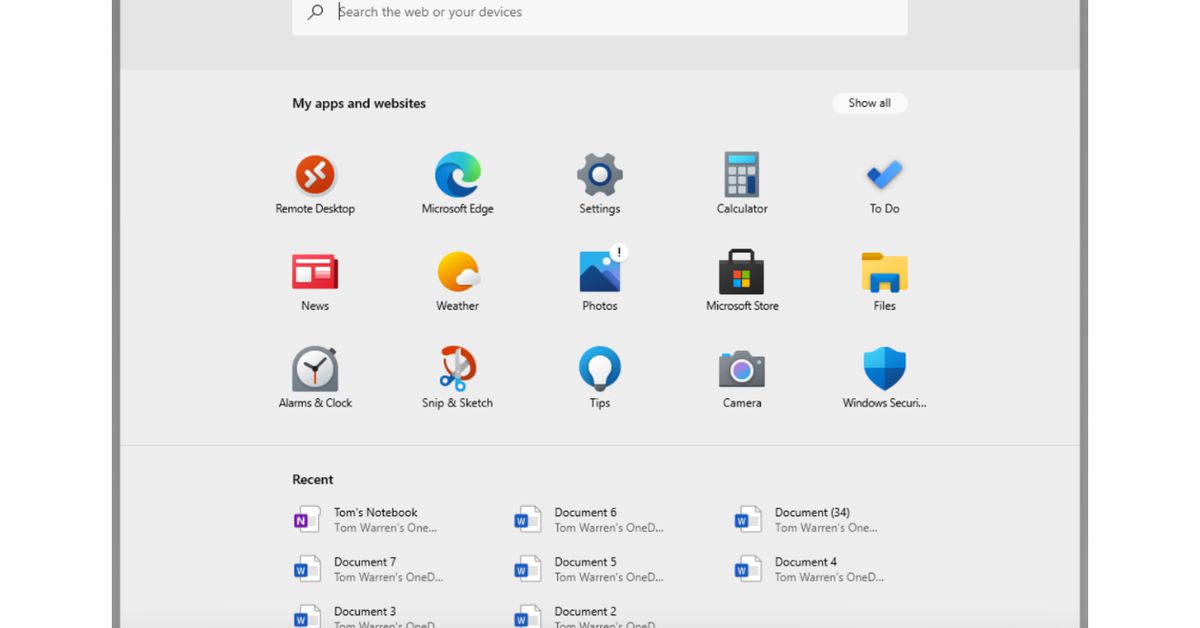After years of waiting, it seems that Microsoft now has a real answer to Chrome OS. A new and almost final version of Windows 10X has leaked and offers a first look at the changes that Microsoft has made to the operating system to prepare it for laptops. Windows 10X started out as a variant of Windows 10 designed for dual-screen devices. It was to be released alongside Microsoft’s Surface Neo, a tablet-like device with two separate nine-inch screens that unfold in a 13-inch workspace.
Microsoft revealed last year that Windows 10X is now being revamped for “single screen” devices, such as laptops, and the Surface Neo has been delayed. Although the company has spent years differentiating Windows 10X for foldable and dual-screen hardware, it now looks and feels more like Chrome OS than ever.
The latest leaked version is an almost final form of what will be released on devices similar to Chromebooks later this year. Windows 10X is not an operating system for which you will be upgrading, or an upgrade that will appear for existing machines. It will only ship with new hardware and is a lightweight version of Windows designed for those who may be tempted to buy a Chromebook.
Windows 10X already looked a bit like Chrome OS on dual-screen devices, but it’s even more apparent now that it’s designed for single-screen laptops. Microsoft has simplified almost every area of Windows within Windows 10X, to the point of looking like a portal to the web instead of a portal to Windows applications.
The Start button is now centered on the taskbar, with a Start menu that acts as an launcher. It does not have the Live Tiles found on Windows 10; instead, it is a list of recent applications and documents. You can also search for applications, documents, or even content on the web through Microsoft’s Bing search engine.
Comparisons to Chrome OS are immediately obvious here, with a launcher and a focus on web apps. You can even install Progressive Web Apps (PWAs) from the built-in Chromium Edge browser and pin them to the taskbar.
This Windows 10X taskbar is also an area of the operating system that has been greatly simplified. You may be used to seeing many application system tray icons, but they don’t exist in Windows 10X. Instead, there is a simple Action Center that displays the time and appears to reveal quick settings, such as turning off a machine, enabling a VPN, connecting monitors, or managing the volume. This also includes access to notifications and an updated widget to control media playback.
Windows 10X windowing has also been simplified compared to Windows 10. You can drag and drop applications to run them side by side, but there is no way to allow applications to be resized freely. As a result, the middle button that you are used to seeing on the top right side of applications (which switches between full-screen and window modes) has been removed 10 times. You can simply minimize the applications or close them here. Laptops that come with Windows 10X will also have gesture trackpad support for multitasking applications.
Microsoft is also working on a modern version of File Explorer on Windows 10X. It was designed primarily as a way to access cloud files from OneDrive, but you can also manage files downloaded here or from USB storage. There is no way to access local files in this new File Explorer, as the 10X is designed primarily for cloud storage.
:no_upscale()/cdn.vox-cdn.com/uploads/chorus_asset/file/22235026/WhCqwih.png?w=560&ssl=1)
It seems that Microsoft may not be supporting desktop applications on Windows 10X, at least initially. Microsoft created container technology to run traditional desktop applications on a lightweight virtual machine. This was originally designed to be used to ensure that legacy applications work correctly with dual screen devices and do not affect battery life or interfere with the way applications are displayed on multiple screens.
Microsoft is still working on this container technology and it appears as a developer-only mode in this latest version of 10X. This may mean that end users will not be able to install regular desktop applications on Windows 10X when it is released. Either way, it’s clear that Microsoft is focusing on a combination of Microsoft Store apps here, as well as web apps.
In a way, Windows 10X looks like a preview of some of the UI and UX changes that we are likely to see in normal Windows 10 later this year. Microsoft is planning a “visual rejuvenation of Windows”, which will include a modernized Start menu, File Explorer and integrated applications that make the Windows 10 UI more consistent.
Microsoft has not yet officially confirmed when Windows 10X will be released, or which laptop manufacturers will launch devices with this operating system variant. Of course, this is a more direct attempt to challenge Chromebooks, after Microsoft tried for years to position Windows 10S as an alternative. This project failed and turned into a simple S mode. In contrast, Windows 10X looks like a much bigger effort to recreate the simplicity of Chrome OS with the added benefit of Microsoft services and applications.
